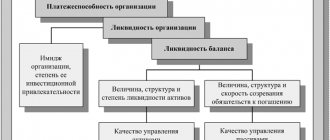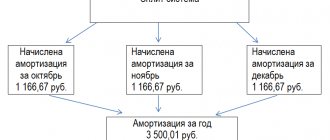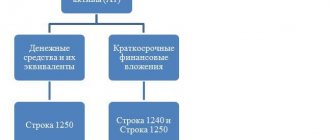If you try to assess the efficiency of staff, the most significant indicators will be the cost of wages and various benefits, time spent on personnel paperwork and the turnover rate. Of these indicators, the last one represents one of the greatest difficulties in calculations and influence on it; there are many objective reasons for this.
Rostrud explains what staff turnover is .
Let's consider what the staff turnover rate is, what algorithms are used to calculate it, and what factors can influence it.
Fluidity is not the opposite of stability
The epithet “fluid” is usually used to characterize liquid substances; it means the instability of the state, the tendency to instantly change it. In relation to personnel, the term “ fluidity ” also means a change in status in the range of “dismissal - employment”. Not only the frequency of changes in this status is taken into account, but also the time during which the employee remains on the staff.
The “staff turnover rate” (CTR) is usually understood as the ratio of employees released from service during the reporting period to their average number for the same time period.
ATTENTION! “The turnover rate is a neutral indicator, but its growth is usually assessed as a negative factor, indicating that employees are dissatisfied with some aspect of the enterprise’s life or that employees are not satisfied with management.
What does the indicator mean?
The staff turnover rate also depends on the adaptation of employees. If, at the end of the analysis, it is revealed that frequent dismissals occur within a short period of time after a person is hired, then the issue is an incorrectly developed adaptation system, as a result of which the new employee cannot join the team. An equally rare phenomenon is mobbing. That is, the team has a negative attitude towards the new colleague and tries in every possible way to “survive” him. These are the most common reasons for high turnover among newcomers.
The indicator can also be calculated by department. In this case, the staff turnover rate makes it possible to identify the shortcomings of department heads and innovations that are unsuccessful for employees. In the latter case, there will be a gradual increase in the number of layoffs after the changes are introduced. In turn, this indicates dissatisfaction with one’s duties, and this can be changed if one makes contact with employees (for example, through voting, interviews or a general meeting).
Does any layoff affect turnover?
Dismissal in itself does not mean turnover. When calculating the required coefficient, only reasons for dismissal are taken into account that do not depend on production or government necessity. These include:
- the employee’s own desire;
- absenteeism;
- leaving without permission;
- violation of discipline or safety regulations;
- failure to pass the certification;
- working translation, etc.
Reasons for dismissal that do not count when determining turnover are:
- reduction in numbers;
- staff reduction;
- reorganization;
- change of leadership and, as a result, personnel changes;
- employee retirement.
Reasons for the high coefficient value
Naturally, there are objective reasons for changes in this or that indicator, including the staff turnover rate, which are as follows:
| Cause | A comment |
| Negative working conditions | An employee gets a job, and then, while performing his professional duties, finds out conditions that are unacceptable to him |
| Lack of growth factors | When working for a long time, an employee does not find factors that could affect his professional growth and development in the company |
| Conflict situations | The presence of conflict situations with other employees or management is a fairly common reason, sometimes of paramount importance when dismissing |
| More favorable conditions | An employee may be offered a more promising job with better conditions in terms of position and salary |
So, we can divide the reasons for leaving an organization into two large groups, namely:
- inside the enterprise (working conditions, remuneration, conflict situations, opportunities and prospects);
- foreign economic and social (economic, social and political situation in the country).
As a rule, first of all, a person’s decision to leave an organization is influenced by reasons within the enterprise, and it is from this moment that it is necessary to analyze the current situation. The most common problems are low wages, conflict situations in the team and negative working conditions. A detailed analysis in each specific case will allow us to identify the reasons for the frequent dismissal of employees and make decisions that will lead to a decrease in the staff turnover rate at the enterprise.
Types of staff turnover
Depending on where exactly the personnel released from their positions move, there are different types of turnover:
- within the organization - employees change positions without leaving the company or enterprise (by their own decision or initiated by management);
- external organizational – employees leave a specific enterprise or change it to another, sometimes even in a different production area.
If we take into account the various parameters for determining fluidity, we can divide fluidity into:
- absolute – the ratio of the number of all laid-off workers to the total composition of the enterprise for the allocated period of time:
- relative - a more accurate indicator that allows you to calculate turnover for each department, within a certain age, gender, among employees with a particular length of service, on grounds for dismissal, etc.
In relation to the reason for leaving, turnover can be:
- active - the employee wants to leave or change jobs because he is dissatisfied with some internal factors: salary, attitude, working conditions, etc.;
- passive - this or that employee does not suit the enterprise in terms of his work or personal qualities.
Turnover in structural units
If employees from one department leave significantly more often than from others, this is a reason to reconsider personnel policies and management attitudes, and possibly other factors. In any case, it is necessary to find out the true reasons.
Turnover by experience
Depending on exactly how long people worked before they quit, a variety of conclusions can be drawn:
- the first six months characterize the effectiveness of personnel selection;
- the first year demonstrates the existing mechanisms for employee adaptation;
- three years speaks volumes about the system of established working relationships and the stability of the organization itself.
Turnover depending on reasons for leaving
The prevailing reasons for dismissing an employee say a lot not only about the employee himself, but also about the order in the company. The work book may say “at one’s own request” or “by agreement of the parties,” but the real reason may well be different. It is better for management and HR to know the real factors influencing turnover than to hide behind soothing language. Only in this case can you influence the state of affairs.
We count staff turnover
The staff turnover rate is one of the three most common criteria for assessing the effectiveness of personnel services, along with compliance with the budget for personnel costs and requirements for maintaining personnel document flow. In this regard, the question is often raised about the algorithm for calculating the turnover rate and what HR managers should do in a situation where they have ceased to influence this indicator due to the processes of personnel reduction that have taken place in many companies.
One of the leading Internet portals devoted to personnel management issues provides the following definition of personnel turnover: “The staff turnover rate is the ratio of the number of dismissed employees of an enterprise who left during a given period for reasons of turnover (at their own request, for absenteeism, for violating safety regulations , unauthorized departure and other reasons not caused by production or national needs) to the average number for the same period.”
Those who calculate this indicator usually have a number of questions:
- What to do with layoffs related to national and industrial needs: retirement, transfer to another place of work?
- What to do with layoffs due to staff reductions?
- What to do with situations when an employee was separated de jure at his own request, but de facto for completely different reasons: be it a violation of labor discipline or a reduction in his position?
In our opinion, the following formula is more correct:
Personnel turnover = number of people who left the company for a certain period / average headcount for the same period × 100.
For example, if 20 people left the company during the quarter when the average headcount in this quarter was 200 people, then the staff turnover rate in the company for the quarter was 10%.
But by calculating this figure as the “hospital average,” we do not receive information for analysis. Unanswered questions remain: “Why did these people leave, “How long did they work at.
Thus, the task of the personnel manager is to identify the reason for the dismissal of each employee and maintain statistics on these reasons. In addition, it is also necessary to keep statistics on layoffs: their number per month, per quarter, per year; distribution of dismissals by department, position, and length of service of dismissed employees.
We recommend calculating the turnover rate by department; by period of work in the company; on grounds of dismissal.
Calculation of turnover rate by department
If in one of the divisions the turnover rate is significantly higher than the company average, you should find out the reasons for this situation. And they can be different: from the management style in the department to the working conditions of employees.
In this case, it is important to draw the manager’s attention to the current situation and, if possible, include the turnover rate as a target KPI (key performance indicator) in the bonus structure of this manager.
The head of one of the warehouse terminals, in a conversation with the HR manager of the central office, explains the high turnover rate among storekeepers by their low salaries.
Before revising salaries, the HR manager decided to analyze whether the turnover rate at this warehouse differed from the company average. It turned out that it differs significantly, which means that the issue is not at all about the wages that are standard for all the company’s warehouse terminals. Probably, the real reason lay in the fact that the boss himself, when hiring new employees, did not choose in favor of the best candidates, which could be a consequence of the boss’s lack of interviewing skills.
Calculation of turnover rate based on length of service in the company
This period depends, first of all, on the average duration of work in the company and can be:
- six months - for companies with a high turnover of personnel, for example, for logistics terminals or large supermarkets;
- year - for most companies;
- three years - for companies like a design bureau, which attracts graduates of specialized universities, additionally training them for another year or two.
The percentage of employees who left the company during the first year of work can be considered an indicator of the effectiveness of the selection and adaptation systems.
The staff turnover rate serves as an indicator of the health of the company and the correctness of management decisions made in the organization. It is important to correctly diagnose the causes of this symptom.
A HR manager at a retail chain of stores noticed that since the beginning of the year, the turnover rate among new salespeople has increased. This trend was surprising in the context of the economic crisis, when the average turnover rate for the company decreased significantly, because people began to “hold on” to their jobs. Moreover, there have been no recent changes in the process of hiring and onboarding employees.
After analyzing the situation, the HR manager suggested that the reason was changes in the employee bonus system initiated in January. As a result, salespeople who had been working in stores for a long time, wanting to get the maximum part of the bonus fund, were not interested in expanding their staff and, as a result, “survived” new employees by working for them and receiving a larger bonus.
Thus, the turnover rate among newcomers in this situation signaled that the bonus system was reorganized incorrectly and requires improvements.
Calculation of turnover rate based on reasons for dismissal
Personnel turnover can be divided into active and passive.
Active staff turnover is a movement of labor caused by employee dissatisfaction with the workplace: working conditions, living conditions, etc.
Passive staff turnover is a movement of labor caused by the employer's dissatisfaction with a particular employee.
When analyzing these indicators, it is important to record the real reasons why the employee left the company. Surely every HR manager has encountered a situation where, although an employee wrote a statement of his own free will, the real reason for the separation was something else: a disciplinary violation or inconsistency with the position.
The company's HR manager usually does not have the opportunity to talk personally with employees resigning from remote offices, so once a month, after all settlements have been made with those dismissed, they should selectively call former employees to understand whether the reasons indicated by managers are true and whether it is hidden under the phrase “ moving to another city” parting with the company due to dissatisfaction or disappointed expectations.
Example questions for dismissed employees:
- When you first started working, who explained your responsibilities to you and introduced you to the rules and features of the activity?
- Have you read the New Employee Folder? Were you given printed materials? Was everything clear to you?
- Did they help you in your work if something didn’t work out? Who? (Manager, colleagues, a little of everything, no one.)
- Have you ever had problems in your team? With whom? (With the manager, with colleagues.) How were the problems solved?
- How can you generally describe the atmosphere in the team?
- What are the reasons for your dismissal?
- Could you recommend your friends to work in this department? And in general in our company?
Thus, for accounting carried out by the personnel service, it is necessary to record the real reasons for dismissal and the initiator of separation. For example, this could be the indicator: “The percentage of employees who worked for less than a year and were dismissed at the initiative of the company in workshop No. 7.”
In conclusion, let us note that there are significant fluctuations in the “staff turnover” indicator among companies in various business sectors. The highest staff turnover is observed in the retail sector.
The turnover rate among top managers and executives is lower than among specialists and such special categories of workers as salespeople, cashiers, and workers. This is explained by the fact that as the position increases, the opportunities for career, financial and status growth within the company increase. As a result, such employees are more attached to their company.
| You need to know this Errors during selection
Adaptation errors
|
Natalya Volodina, Kadrovik.ru
staff turnoverpercentage of staff turnoverhow to calculate the staff turnover rate
Formula for calculating staff turnover rate
It is convenient to calculate the fluidity coefficient using the formula:
KTK = (USZh + UIR) x 100 / SCH,
where KTK is the staff turnover rate; USH - the number of employees dismissed at their own request; UIR - the number of employees dismissed on the initiative of management (for absenteeism, criminal record, violation of discipline, etc.); Average number of employees for the reporting period.
Headcount is an independent indicator
IMPORTANT! Recommendations for calculating the average number of employees from ConsultantPlus are available here
The number of personnel on the lists for the reporting period reflects the dynamics of the composition of the workforce. In order to determine it, you need to note the number of employees on this date every month (usually this is done on the 1st of the month).
The next step depends on the reporting period for which you need to calculate the SP or CTC: sum up the obtained figures and divide by the number of months.
For example, for a year the average will be: (C1+C2+C3…+C12)/12. Sometimes they count in pairs of months, adding up the indicators of each two months and dividing them by 2, taking the required number of pairs for the reporting quantity: (C1+ C2)/2 + (C3+C4)/2 +…
Fighting problems that at first glance cannot be solved
In some regions, the main reason for employee layoffs is the need for housing. Not every company can provide a place in a dormitory, not to mention a service apartment or house. Such problems should, of course, not be resolved at the level of company management, but rather in the administration of a city or federal subject. In this case, an option for financial incentives for employees may work, such as partial (or full - depending on the company’s budget) payment for rented housing.
Absolute and relative rates of turnover
Approximate limits have been established within which turnover is considered normal - 3-5%; a relatively stable team has a CPC of 5-9%. An indicator of less than 3% indicates stagnation, figures of more than 50% indicate serious problems.
It is possible to more accurately determine turnover limits depending on specific indicators.
- Different indicators may be considered the norm for workers at different levels:
- for high-level managers – 0-2%;
- ordinary managers – up to 10%;
- ordinary employees – up to 30%;
- unqualified personnel – up to 50%.
- Limits vary greatly in different areas of work:
- computer technologies – 8-10%;
- production – 12-15%;
- trade – up to 30%, etc.
IMPORTANT! CPC and SP are indicators that are the most informative when viewed over time.
Where and what is it used for?
This indicator is used in personnel services, personnel management services, labor and wage organization, financial and economic (depending on the organizational structure of the enterprise) as an indicator showing the level and nature of the movement of labor.
Like any indicator, this indicator informs us whether there are problems at the moment or whether everything is going well. Normal values mean the values that have developed in practice for various categories of personnel, sectors of the national economy and stages of development of the organization.
Human capital management specialists should keep constant records of layoffs by personnel category and by company division, examining not only the quantitative but also the qualitative characteristics of the phenomenon, that is, analyzing the reasons for staff turnover.











